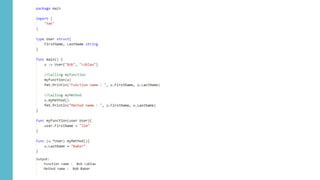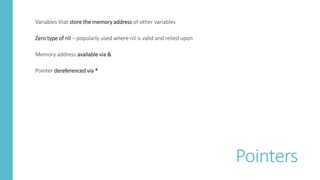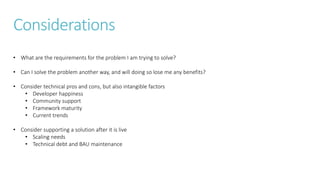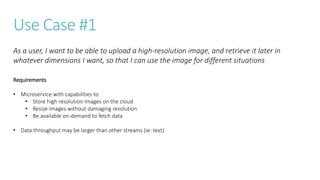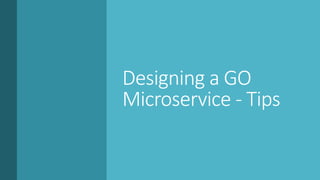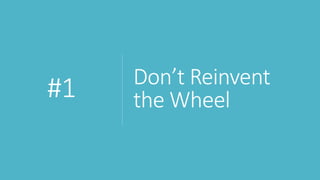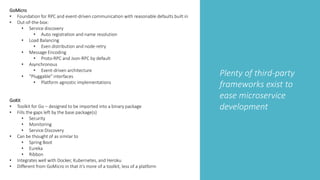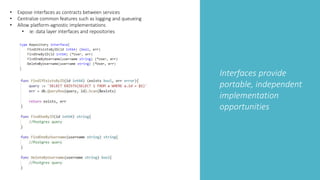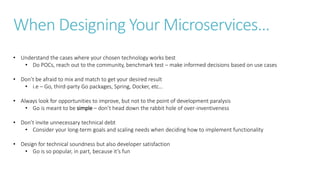Introduction to GoLang
- 1. Hurry Up and Go (But Not Too Fast) Stuart Fettinger [email protected]
- 2. About Me Project Architect at NVISIA 10+ years of experience designing, developing, and delivering solutions Recent co-founder of a tech startup Passionate about limiting tech debt through clean and efficient design
- 3. Topic Breakdown Brief Introduction to GO Guiding Principles and Core Concepts Go’s strong (and not so strong) suits Highlighting when GO is a preferred choice, and when it’s not, through real-world examples Designing a GO Microservice Tips for your design to take advantage of Go to its fullest and avoid common pitfalls
- 5. • Developed by Google in 2007 • Designed to overcome criticism of other languages •Statically typed and compiled • Syntactically similar to C
- 6. Go’s Guiding Principles Simplicity Type inference Declare-and-initialize operations No generics Composition rather than inheritance Readability As little “magic” as possible Explicit and lean error mechanisms Orthogonality Do one thing well, keep things simple, standardize communication Elimination of cross-linking complexity Performance Built in garbage collection Synchronization, channels and Go routines Pointers
- 7. A Basic Example Main package – compiled binary Short, concise imports Function keywords Multiple return values Meaningful spaces – no semicolons
- 9. Packages provide logical groupings and reusable functionality Every Go program starts in the main package’s main() function Main package is compiled to binary Functions beginning with a capital letter are exported outside their package Functions beginning with a lowercase letter are essentially private Packages
- 11. Functions are stand-alone pieces of functionality Methods are functions with receivers - tied to a type Methods should be used when state is important and with interfaces Rule of thumb – prefer methods over functions Methods vs. Functions
- 13. Variables that store the memory address of other variables Zero type of nil – popularly used where nil is valid and relied upon Memory address available via & Pointer dereferenced via * Pointers
- 16. Structs Named collections of fields When initialized, all fields are set to their zero values Fields of a struct are accessed via “.” operator Composition over inheritance – one struct cannot be the child of another Structs can contain other structs
- 18. Named collections of method signatures No “Implements” keyword – can be implemented directly by implementing all methods Interfaces can be empty – automatically satisfied by any type Go’s answer to polymorphism Interfaces
- 20. Errors Errors are treated as values Stack traces don’t come for free with errors Idiomatic to check for errors frequently via “if” operations No try/catch framework – error handling up to developers
- 22. Go Routines Lightweight threads managed by the Go runtime Spawned by simply using “go” keyword Initially small stack size with ability to scale Leverage channels to pass messages, block, and sync between Go routines Performant – can run thousands of Go routines at a time with little drag
- 24. What Go Doesn’t Have • Inheritance • Classes • Exceptions • Generics
- 25. Deciding When to Use Go
- 26. Go Is Not One-Size Fits All • Go works well in some cases, not so great in others • Some scenarios to consider Go • Small, predictable routines • Where performance margins are razor thin (ie: trading) • Quick start-up with limited resources • Scaling is a prime factor or an unknown • Concurrency and communication is a prime use-case • Scenarios where Go may fall short • Where complexity requires extensive third-party libraries • Where OO reduces complexity • Front-end MVC • Team makeup is less experienced • Remember – design decisions should be case-by-case – try not to promote blanket use of technology
- 27. Considerations • What are the requirements for the problem I am trying to solve? • Can I solve the problem another way, and will doing so lose me any benefits? • Consider technical pros and cons, but also intangible factors • Developer happiness • Community support • Framework maturity • Current trends • Consider supporting a solution after it is live • Scaling needs • Technical debt and BAU maintenance
- 28. Use Case #1 Requirements • Microservice with capabilities to • Store high resolution images on the cloud • Resize images without damaging resolution • Be available on-demand to fetch data • Data throughput may be larger than other streams (ie: text) As a user, I want to be able to upload a high-resolution image, and retrieve it later in whatever dimensions I want, so that I can use the image for different situations
- 29. Use Case #1 Performance exceeds that of an interpreted language Package manager and libraries are more diverse Higher scalability to meet unknown data demands Ease of using docker to spin up containers Serverless architecture support Further developed community Smaller learning curve for front-end developers Channels and GoRoutines to spread out workloads
- 30. Use Case #2 Requirements • Several microservices connecting with different resources and providing different outputs • Similarities in data may be a high percentage of make-up • Data has potential to be large – multi-threading may be important As a user, I want to be able to call APIs for different but similar data, and aggregate them together, so that I can streamline my usage of that data
- 31. Use Case #2 Lightweight syntax – avoid getting lost in complex data manipulation Inheritance and genericsHigh Performance Mature libraries for persistence and data combination Go Channels and Go Routines – automate polling data Extensive API strategy support
- 32. Use Case #3 Requirements • Many file types may exist in many different formats • Files may be made available at different times • Must store data, potentially in a variety of formats As a user, I want to be able to ingest and persist files from many different sources, so that I can scrape the data later via my own processes
- 33. Use Case #3 Significant performance benefits Mature ORM libraries Low learning curve Wide database support Higher developer popularity Multithreading capabilities
- 34. Use Case #4 Requirements • Application available on the web, potentially mobile as well • Rich Interface and modern design • Communicates with various microservices • Possibilities are endless – login, registration, alerts, etc… As a developer, I want to create a front-end web application for my users to interact with, so that I can expand my customer base
- 35. Use Case #4 Lower learning curve Mature MVVM patterns and support Templating and rendering engines High number of built-in must-haves for front- end development Third-party routing support Seamless integration with a back-end Go stack (Revel)
- 36. Designing a GO Microservice - Tips
- 38. Plenty of third-party frameworks exist to ease microservice development GoMicro • Foundation for RPC and event-driven communication with reasonable defaults built in • Out-of-the-box: • Service discovery • Auto registration and name resolution • Load Balancing • Even distribution and node-retry • Message Encoding • Proto-RPC and Json-RPC by default • Asynchronous • Event-driven architecture • “Pluggable” interfaces • Platform agnostic implementations GoKit • Toolkit for Go – designed to be imported into a binary package • Fills the gaps left by the base package(s) • Security • Monitoring • Service Discovery • Can be thought of as similar to • Spring Boot • Eureka • Ribbon • Integrates well with Docker, Kubernetes, and Heroku • Different from GoMicro in that it’s more of a toolkit, less of a platform
- 40. Interfaces provide portable, independent implementation opportunities • Expose interfaces as contracts between services • Centralize common features such as logging and queueing • Allow platform-agnostic implementations • ie: data layer interfaces and repositories
- 42. Make your entities more meaningful by tying them to an ORM implementation Go’s lean syntax drives you to use straight SQL prepared statements • Gets messy fast with many parameters and outputs • Nil considerations are difficult – Go values not easily nillable • Compiler will not catch issues with prepared statements, field names, etc... GoRM • Provides associations between entities – Has One, Has Many, Many to Many, Belongs To, etc… • Uses any field with ID as the primary key – no need to annotate • Auto support for creation, update, and soft-delete timestamps • Auto-update capabilities – No need to explicitly call update vs insert • Provides hooks to execute functionality pre or post running SQL • API for transaction management and rollback • Eager loading vs lazy loading (default) capabilities • Can run raw SQL if needed
- 44. Go’s binary nature may drive you to place configs in files within the application, or on the server in a central location • It works – but you’re missing out Create a central location where configurations live – ideally another microservice serving up files • Place security on top of configs • Integrate with CI/CD pipelines • Inject configs via use of Docker secrets, etc… • Leverage caching for failure scenarios Read configurations into your services by leveraging Go-based configuration solutions Viper • API to find and load config files of varying formats • Also supports writing configuration files • Provides defaults and gracefully handles overrides • Live-watching of configs, and hot-reloading • Alias-based naming, allowing non-breaking renames • Uses environment variables to manage different configurations • Remote key/value store support Centralized configuration keeps things DRY
- 46. • Errors are values so it’s easy to treat them as strings and just pass them up the chain • There is no stacktrace included with an error by default • There is no concept of an exception in Go – up to the developer to handle • Implement the error interface to construct meaningful errors of different types • Add stack trace information by using go-errors package • Add important logging info using go log flags Supplement your error framework with additional logging and packages
- 47. When Designing Your Microservices… • Understand the cases where your chosen technology works best • Do POCs, reach out to the community, benchmark test – make informed decisions based on use cases • Don’t be afraid to mix and match to get your desired result • i.e – Go, third-party Go packages, Spring, Docker, etc… • Always look for opportunities to improve, but not to the point of development paralysis • Go is meant to be simple – don’t head down the rabbit hole of over-inventiveness • Don’t invite unnecessary technical debt • Consider your long-term goals and scaling needs when deciding how to implement functionality • Design for technical soundness but also developer satisfaction • Go is so popular, in part, because it’s fun
- 48. Questions












